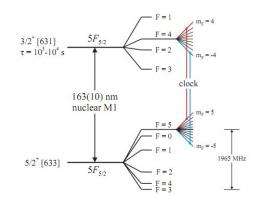November 9, 2011 report
Research team shows nuclear clock could be 60 times more accurate than atomic clock

(PhysOrg.com) -- For almost sixty years, the world has considered the atomic clock the gold standard for keeping time. Its accuracy is such that it drifts by only about four seconds over a period of about thirteen and a half billion years (about the time since the Big Bag is thought to have occurred). Now it appears a new more accurate way to measure time might be on the horizon. Corey Campbell at the Georgia Institute of Technology and five of his colleagues have teamed together to describe in their paper pre-published on arXiv, how a more accurate nuclear clock might be devised.
While the atomic clock is based on vibrations of electrons orbiting an atom, the nuclear clock would instead be based on tuning the spatial orientation of electrons that cause the nucleus of an atom to jump back and forth between high and low energy states using a very specific frequency of light. The result, the researchers say, would be a clock tuned by a laser that would drift only about one second in 200 billion years, or 14 times the believed age of the universe and 60 times more accurate than current atomic clocks. The only trick here apparently, is in figuring out just what that frequency would be.
For most people, the accuracy of a clock isn’t really all that much of a big deal. For this reason something called Coordinated Universal Time (UTC) is used for ordinary living. It’s derived from atomic clock measurements but also uses leap seconds based on the rotation of the earth to help keep everyone straight. For other applications though, more accuracy is needed. GPS is one such example. Because there are four satellites used for GPS tracking, some means of timing their signals must be used to coordinate data sent from them and relayed to Earth based navigation systems. The smaller the errors in timing, the more accurate the systems become.
The main reason the nuclear clock would be so much more accurate than the atomic clock is due to the fact that atomic clocks are susceptible to ambient magnetic and electric fields that can throw off the vibrations of the electrons a tiny bit. Using a laser to precisely control the nucleus bouncing between states however would not be nearly as susceptible to such interference.
More information: A Single-Ion Nuclear Clock for Metrology at the 19th Decimal Place, arXiv:1110.2490v1 [physics.atom-ph] arxiv.org/abs/1110.2490
Abstract
The 7.6(5) eV nuclear magnetic-dipole transition in a single 229Th3+ ion may provide the foundation for an optical clock of superb accuracy. A virtual clock transition composed of stretched states within the 5F5/2 electronic ground level of both nuclear ground and isomeric manifolds is proposed. It is shown to offer unprecedented systematic shift suppression, allowing for clock performance with a total fractional inaccuracy approaching 1 x 10^-19.
via Newscientist
© 2011 PhysOrg.com
















